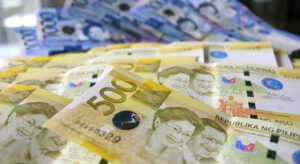By Keisha B. Ta-asan, Reporter
CREDIT GROWTH further slowed to a 21-month low in September as high interest rates continued to dampen demand for loans. Data from the Bangko Sentral ng Pilipinas (BSP) released on Monday showed outstanding loans by big banks, net of reverse repurchase (RRP) placements with the central bank, grew by 6.5% year on year to P11.17 trillion in September, slowing from the 7.2% growth logged in August.
The September pace was the slowest in 21 months or since the 4.8% expansion recorded in December 2021. September also marked the sixth straight month that loan growth eased.
On a month-on-month seasonally adjusted basis, lending net of RRP placements with the BSP inched up by 0.7%.
“Slower bank lending was to be expected, showcasing the fallout from policy rate hikes,” ING Bank N.V. Manila Senior Economist Nicholas Antonio T. Mapa said in an e-mail. “BSP rate hikes have a 9-12-month delay, and we are now seeing those hikes take hold.”
The BSP’s benchmark interest rate has been at a near 16-year high of 6.25% from March until October this year. It raised the policy rate by 25 basis points to 6.5% in an off-cycle move on Oct. 26.
“More concerning is the slowdown of lending to productive activities, which indicates productive capacity will be curtailed further,” Mr. Mapa said.
Based on BSP data, borrowings for productive activities rose by 4.9% to P9.65 trillion in September, slower than the 5.5% growth seen a month prior.
China Banking Corp. Chief Economist Domini S. Velasquez said loan growth to productive activities markedly slowed from double-digit growth rates in 2022.
“Loans to the manufacturing sector softened, aggravated by a tepid global trade. Segments under the services sector have also showed signs of deceleration such as accommodation and food service activities,” she said.
According to the BSP data, there was an annual decline in loans for professional, scientific, and technical services (-10.9%), education (-10.9%), manufacturing (-3.8%), as well as accommodation and food service activities (-1.6%).
Meanwhile, loan growth was recorded for major sectors such as electricity, gas, steam, and air-conditioning supply (9.2%); information and communication (8.1%); wholesale and retail trade, and repair of motor vehicles and motorcycles (6.6%); real estate (5%); and financial and insurance activities (4.9%).
The slowdown in lending to productive activities reflects the contraction in capital formation reported in the third-quarter gross domestic product (GDP) data, Mr. Mapa added.
Gross capital formation declined by 1.6% in the third quarter, ending nine straight quarters of growth. This was a reversal of the 18.2% expansion a year prior and 0.3% in the second quarter.
Despite this, the Philippine economy expanded to 5.9% in the third quarter due to robust government spending. This was significantly faster than 4.3% in the second quarter but slower than 7.7% a year earlier. Year to date, economic growth has averaged 5.5%.
Meanwhile, outstanding loans to residents, net of RRPs, rose by 6.6% to P10.85 trillion in September, easing from the 7.2% growth in August.
Total loans to nonresidents, net of RRPs, also inched up by 0.3% to P325.704 billion in September, significantly slower than the 8.4% growth seen the previous month. “On a positive note, consumer loans sustained its robust expansion with no immediate signs of weakening,” Ms. Velasquez said.
Consumer loans to residents jumped by 23.5% to P1.19 trillion, slightly faster than the 23.1% growth in August.
Broken down, annual increases were seen in credit card loans (30.4%), motor vehicle loans (13.4%), salary-based general purpose consumption loans (14.5%), and others (73.1%).
“Looking ahead, we anticipate that consumer loans will benefit from a slowdown in inflation and ongoing support through remittances and a strong labor market,” Ms. Velasquez added.
MONEY SUPPLYDespite slower growth in bank lending, domestic liquidity continued to expand by 7.9% to P16.6 trillion in September. This was faster than the 6.8% print in August, separate BSP data showed.
M3 or the broadest measure of liquidity in an economy edged up by 1% on a month-on-month seasonally adjusted basis.
Domestic claims rose by 9.5% in September from the revised 9.3% in August.
Claims on the private sector grew by 6.3%, slower than the revised 7.5% growth in the previous month, amid increased lending to nonfinancial firms and households.
Meanwhile, net claims on the central government also went up by 19.2% in September from the revised 15.2% in August, due to the decline in deposits by the National Government with the central bank.
Net foreign assets (NFA) in peso terms grew by 1% in September, slowing from the revised 3.5% expansion in the prior month.
“The BSP’s NFA grew by 2.3% in September after expanding by 3.2% in the previous month. Meanwhile, the NFA of banks contracted on account of higher bills payable and foreign deposit liabilities,” the central bank said.
“Looking ahead, the BSP will continue to ensure that domestic liquidity conditions remain in line with the prevailing stance of monetary policy, consistent with its price and financial stability objectives,” it added.






